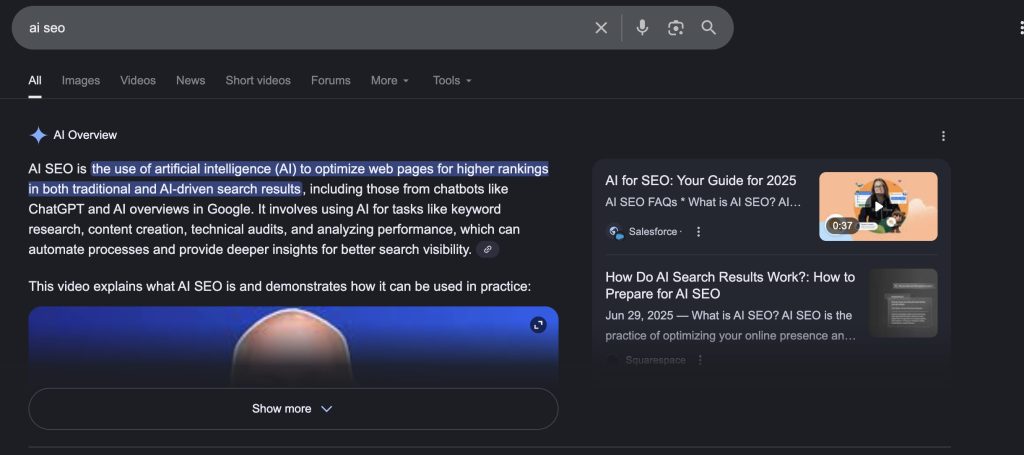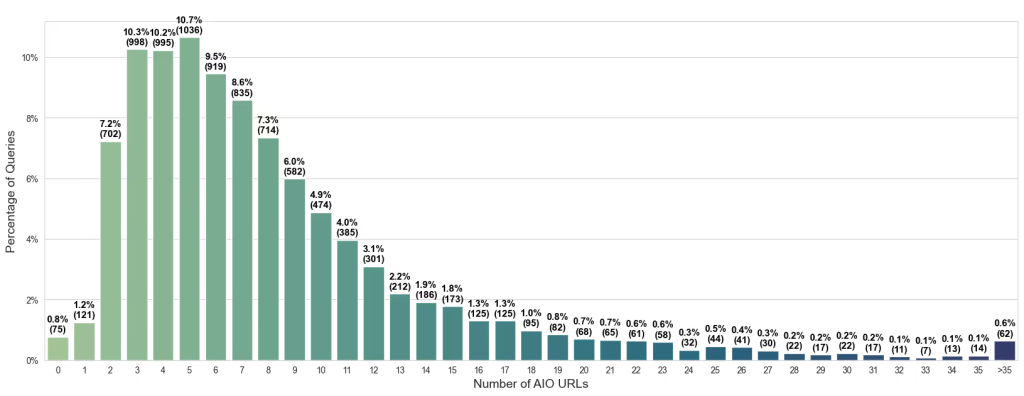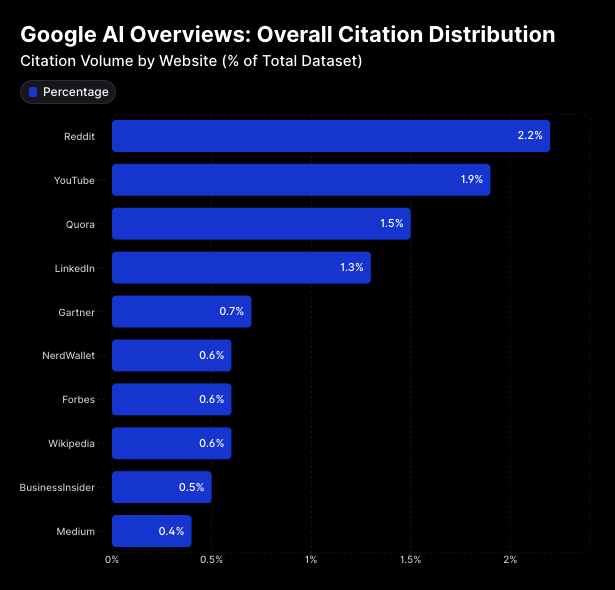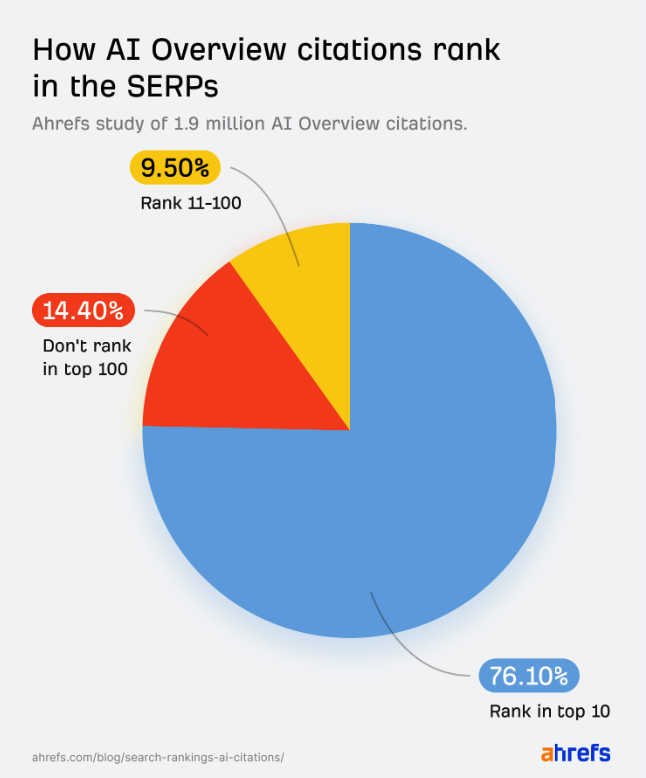Google’s AI Overviews don’t cite sources at random instead they pick pages that answer the query with authority, clarity, and context.
If your content matches the intent better than anyone else’s, you can earn a coveted citation even when you’re not ranking #1. That means brand visibility at the very top of the SERP, trust by association, and a real shot at incremental traffic.
In this guide, we’ll cut through the noise and show you how those citations are actually chosen and what you can do to become one of them.
We’ll break down the signals that consistently show up in cited pages (topical depth, entity coverage, clean structure, schema, original data, and reputation), then turn them into a repeatable checklist you can deploy across your site.
In this article…
- What Are Google’s AI Overviews?
- How Do Google’s AI Overviews Choose Which Sources to Cite?
- Do High-Ranking Pages Automatically Get Cited in AI Overviews?
- Why Do Some Sources Get Repeatedly Cited in AI Overviews?
- How Do You Optimize Your Pages to Get Cited in AI Overviews?
- Do Citations in AI Overviews Change Traffic & Strategy?
- Conclusion
- FAQ – How Google AI Overviews Selects Sources
Key Takeaways
- Structure beats fluff: Answer-first, fan-out-aligned sections, and compact data make you trivially extractable.
- Authority still matters: Earn trustworthy links and references to de-risk synthesis and lift odds.
- Freshness wins ties: Timestamped updates and clear versioning improve inclusion on evolving topics.
- Semantics are leverage: Titles/slugs/H1s must mirror the exact task phrasing users type.
- Track to improve: Monitor citations oveale.
What Are Google’s AI Overviews?
Google’s AI Overviews are machine-generated summaries at the top of search that synthesize answers from multiple web pages and link out to them.

They matter because they can steal or award massive attention before the first organic result. But what gets your page into that box?
Google formally rolled out AI Overviews in May 2024, positioning them as a way to answer complex, multi-step queries with a single, scannable summary that still “prominently includes links to learn more.”
In plain English: search now writes a first-draft answer and then points users to supporting sources it trusts.
Over time, Google has expanded availability and emphasized that AI experiences show links in varied ways to encourage exploration, not just zero-click consumption.
From a user’s perspective, an AI Overview combines three things: (1) a synthesized explanation, (2) a set of cited source cards, and (3) suggested follow-ups that let you keep drilling down inside the SERP.
From a publisher’s perspective, the game changes: visibility isn’t just rank; it’s citation.

Unlike a traditional Featured Snippet that usually quotes one page, AI Overviews blend multiple sources into a composite answer.
That means your content can earn top-of-page exposure even if you’re not position #1, provided it aligns tightly with the query and demonstrates trust.
Snapshot: What’s inside an AI Overview
Below is a quick breakdown of the feature components and the leverage each creates. The bullets call out exactly what to optimize later in the playbook.
- Answer block: A condensed paragraph or two that resolves the query’s core intent.
- Citations/links: Source cards (often 3–5) that support specific statements in the answer.
- Follow-ups: Auto-generated questions that expand or narrow the task.
- Traditional results: Organic listings still appear so your page can be both cited and rank below.
| AI Element | What Users See | Why It Matters to You |
| Overview text | A synthesized explanation of the answer | Sets the framing your brand can “own” if cited |
| Source cards | Clickable links to supporting pages | Primary visibility lever (brand + traffic) |
| Follow-ups | Next questions to refine intent | More entry points for your content cluster |
| Organic results | Standard blue links below the box | Insurance: ranking still counts alongside citations |
Google’s own guidance to site owners is clear: keep creating people-first content, use solid structure, and make it easy for Search to surface your pages in AI experiences.
Practically, that means clean headings, concise answers above the fold, stable canonical URLs, and helpful signals (schema, tables, lists) that are simple for models to parse.
The punchline: you’re optimizing for readability and machine interpretability at the same time.
How Do Google’s AI Overviews Choose Which Sources to Cite?
They pick pages that fully satisfy the intent, match entities precisely, and are trivially easy for a model to parse then expand the pool via “query fan-out” to cover subtopics.
If you structure answers cleanly and prove trust, you can win citations even without ranking #1.
Google has said there’s no special “AIO schema” or magic tag.
Instead, AI Overviews surface links the system deems most helpful while it composes the summary, often issuing related searches (fan-outs) to fetch supporting pages across subtopics.
Independent studies back this up: AIO typically cites multiple sources (on average ~8 per response), heavily biased toward pages already in the top 10 organic results but not exclusively so.
Which means classic SEO signals still matter, yet structure and topical completeness decide who gets the nod inside the box.
How the selection works
Two sentences first, then a list that you can copy into your playbook. The bullets mirror what we repeatedly observe in cited pages across categories.
- Query understanding → fan-out: Google expands the original query into related angles to assemble a complete answer.
- Candidate retrieval: It pulls pages that best match each subtopic and entity.
- Quality/coverage scoring: Clear structure, trustworthy signals, and recency lift candidates.
- Dedup & diversity: The system balances authority with coverage, then formats source cards.
In Surfer’s dataset, ~70% of citations come from the top 10 organic results (including fan-out queries), and AIO responses show ~8 sources on average (<1% of AIOs have no sources).

Source: SurferSEO
Primary signals AIO rewards
Two short lines first, then specifics. Use this as a build spec for pages you want cited in AIO.
- Complete, on-intent coverage: Answer the head question fast, then cover adjacent subtopics the fan-out will likely fetch.
- Machine-readable structure: Headings, lists, tables, and consistent schema that mirrors visible text.
- Trust & topical authority: Demonstrable expertise, stable canonicals, and a clean link graph.
- Recency & correctness: Fresh updates for time-sensitive topics.
- Entity precision: Disambiguate names, versions, and product models in plain language.
Table: What AIO is likely scoring
| Signal | What it influences | What to do |
| Coverage depth | Whether your page can support the entire summary (and follow-ups) | Map subtopics with a brief FAQ on-page; include definitions, steps, exceptions |
| Structure clarity | Ease of parsing and snippet extraction | Use H2/H3s that echo the query; add bullet lists & summary boxes near the top |
| Schema alignment | Confidence in facts & entities | Apply schema that matches visible text; avoid bloated, off-topic markup |
| Authority & citations | Confidence and de-risking hallucinations | Earn mentions/links from relevant, trusted domains; cite primary sources |
| Freshness | Preference on newsy or evolving topics | Add “Last updated” stamps; refresh when facts change |
| Fan-out relevance | Inclusion across related subqueries | Cover adjacent intents (pros/cons, costs, steps, tools) within one page or cluster |
Evidence base: Google’s “AI features” doc confirms fan-out behavior; independent studies find multi-source responses and strong overlap with top organic results, plus recurring “core sources” that get reused.
The “core vs. non-core” source effect
Short version first: Google reuses a small set of URLs for the same prompt across runs (“core sources”), while others appear once (“non-core”).
If you become a core source for a topic, you capture repeated AIO visibility even when rankings wiggle.
Surfer’s analysis shows two tiers of sources: a smaller “core” cohort that repeatedly appears for a query and a larger “non-core” group that rotates in and out.
Core sources tend to have tighter semantic alignment (title/slug mirroring the query) and generally stronger organic positions, which reinforces the inclusion loop.
Practically, this pushes you toward exact-match, natural language titles and laser-focused slugs, plus relentless coverage and internal linking so your page remains the best “explain it all” candidate over time.
Design your page for AIO retrieval
Each item is implementation-ready.
- Lead with the answer: 2–4 sentences above the fold that resolve the intent, followed by a scannable outline.
- Mirror fan-out: Add mini-sections for “What/How/Why/Do,” plus synonyms and related entities.
- Use compact data: Tables for specs, timelines, costs; bullets for steps and pros/cons.
- Schema that matches text: Don’t stuff; reflect what’s visible (FAQ, HowTo, Product, Article).
- Tight semantics: Align title/slug/H1 with the exact task users phrase.
- Evidence links: Outbound to primary sources to anchor facts (studies, standards, docs).
Reality check: Interface and volatility
AIO’s presentation keeps evolving; Google has tested formats that surface source links more prominently and experimented with inline link anchors.
Expect volatility in which URLs get cited from day to day which is why becoming a “core source” is your insurance policy as the Verge likes to call it.
Pro move: Turn authority and structure into compounding odds
Two lines first; then we’ll connect it to your growth levers with suggested interlinks.
Authority still weighs the dice, but structure decides the draw. Build links the right way and package answers so a model can’t miss your relevance.
For competitive or YMYL queries, both are mandatory.

Source: Profound
Profound’s cross-platform citation research found Google offers more citation slots than most answer engines, increasing the chance your brand appears multiple times if your content exists across subtopics and domains.
Do High-Ranking Pages Automatically Get Cited in AI Overviews?
No. Ranking helps, but it doesn’t guarantee a citation. Multiple studies show strong overlap with top results but a meaningful share of citations still come from pages outside the top 10.
High positions increase your odds because Google’s AI frequently pulls from already-trusted pages.
Ahrefs found 76.1% of cited URLs rank in the top 10; Surfer reported roughly 70% from the top 10; seoClarity’s large-scale analysis shows heavy overlap with top-20 results.

Source: Ahrefs
Yet the same datasets (and others) show non-trivial outliers: Ahrefs observed 14.4% of AIO citations from URLs ranking outside the top 100 which is proof that structure, entity clarity, recency, and intent match can catapult a lower-ranked page into the Overview.
This quick list calls out patterns we see repeatedly in AIO citations. Use it to diagnose why a #3 page gets ignored or why a #22 page sneaks in.
- Strong rank, weak structure → missed citation. Top pages that bury the answer or lack lists/tables/schema often lose to clearer, smaller sites.
- Mid/low rank, perfect parse → surprise inclusion. Clean H2/H3s, FAQs, and entity-precise copy make you trivially extractable.
- Freshness beats static authority in time-sensitive topics. Recently updated, well-sourced posts jump the queue even if they’re not #1.
- Diverse source mix by design. Google spreads citations across formats (sites, forums, video, professional networks) to cover angles, not just “the winner.”
Table: Rank vs. AIO citation likelihood (what tips the scales)
| Scenario | Rank Position | Citation Odds | Why it wins/loses |
| #1 page, weak structure | 1–3 | Medium | Hard to parse; lacks explicit answer, lists, schema. |
| #5 page, answer-first + tables/FAQ | 4–10 | High | Mirrors AIO summary format; easy extraction. |
| #15 page, entity-precise & freshly updated | 11–20 | Medium–High | Matches intent; freshness + clarity beat position. |
| >100 (not ranking) but perfect structure & niche authority | 100+ | Low–Medium | Outlier cases still happen (≈14% in one study). |
Why Do Some Sources Get Repeatedly Cited in AI Overviews?
Because Google tends to “lock in” a small set of URLs that consistently satisfy the query and its fan-out subtopics.
Those become core sources and reappear across refreshes; others rotate in and out as non-core and that rotation is your opening.
Google’s own documentation confirms the query fan-out step: the system explodes a question into sub-queries, pulls candidates, and then composes a single answer with multiple citations.

In practice, some pages keep proving they’re the best fit for those sub-queries (tight semantic alignment, answer-first formatting, stable authority), so they’re reused.
Surfer’s large-scale study names these “core sources” and shows they recur for the same prompt across runs, while non-core sources appear once and vanish.
Core sources also tend to have stronger semantic alignment (title/slug mirrors the query) and usually rank higher organically.
What “core” actually means (and how it differs from “non-core”)
Below you’ll see a quick table to make the distinction concrete. After that, a punch-list you can deploy this week to tilt odds toward “core” status.
| Attribute | Core sources | Non-core sources |
| Recurrence | Reappear across multiple runs for the same prompt | Show once, then drop |
| Semantic alignment | Titles/slugs closely match the task phrasing | Broader or fuzzier match |
| Organic overlap | Skews higher vs. peers | Mixed; can be mid-pack or low |
| Role in answer | Anchors key claims or steps | Fills gaps/edges for diversity |
| Volatility | Lower (but not immune) | Higher; rotate frequently |
Why some non-core URLs still break through
Even with “core” gravity, Google mixes in diverse formats (forums, video, professional profiles) to cover angles and reflect the web.
Independent datasets show AIO citations heavily overlap with top organic results, yet a meaningful slice can come from beyond the top 10 when those pages offer cleaner structure, fresher facts, or a sharper sub-topic fit.
Numbered playbook: move from “candidate” to “core”
This is the operational checklist we deploy on live pages.
- Tighten semantics: rewrite title/H1/slug to reflect the exact task phrasing users type.
- Front-load the answer and add a 5–7 bullet “summary box” below it.
- Map fan-outs: add short blocks for definitions, steps, costs, pros/cons, common mistakes.
- Add compact tables for any numeric comparisons (features, pricing, timelines).
- Align schema to the visible UI with no stuffing; validate it.
- Cite primary sources for any stats or standards; keep outbound links tight.
- Instrument freshness: note update dates and what changed; revisit quarterly for moving topics.
How Do You Optimize Your Pages to Get Cited in AI Overviews?
Lead with the answer, mirror likely fan-outs, and make extraction stupid-simple (lists, tables, FAQ, aligned schema).
Then back it with authority and freshness. Do this correctly and you’ll win citations even when you’re not #1.

Google’s documentation is explicit about the direction: AI experiences surface links “in a range of ways,” reward helpful content, and lean on a broader set of sources for exploration.
Independent studies show most citations come from already-trusted pages, but structure and coverage decide who makes the cut inside the box.
Translation: combine classic ranking signals with machine-readable formatting that lines up perfectly with the query and its sub-questions.
The framework below shows what to change on a single page and across your cluster to become the obvious candidate.
AIO-Ready Page Blueprint
These bullets map 1:1 to elements AI Overviews commonly surface. The list is short on prose and long on things you can actually ship this week.
- Answer block above the fold: 2–4 sentences that resolve the exact task.
- Fan-out mini-sections: What / How / Do / Why + steps, costs, pros/cons, exceptions.
- Compact data: Tables for specs/timelines; bullets for steps; short definitions.
- Schema parity: FAQ/HowTo/Article that matches visible text (no stuffing).
- Evidence links: Outbound to primary sources for any facts/stats.
- Freshness: Date-stamped updates for moving topics.
Table: Page Elements → What to Ship → Why It Gets Picked
Two rows in and you’ll see the pattern. Build all of them for compounding odds.
| Element | What to ship this week | Why AIO favors it |
| Above-the-fold “Answer” | 2–4 sentence summary + anchor links to sections | Mirrors the Overview’s own summary format. |
| Fan-out coverage | H2/H3 blocks for steps, costs, exceptions, comparisons | Covers sub-queries the model retrieves. |
| Compact data | 1–2 small tables (features/prices/timelines) | Easier to parse than prose; fewer ambiguities. |
| Schema parity | JSON-LD for FAQ/HowTo aligned to visible Q&A/steps | Confirms entities and structure. |
| Entity precision | Versions, models, dates spelled out in headings | Disambiguates for retrieval and ranking. |
| Freshness | “Last updated” + change log snippet | Wins recency tie-breakers on evolving topics. |
On-Page Template
Two short paragraphs explain the block; the numbered list is your paste-ready scaffold.
Use this to retrofit existing articles or draft new ones. It aligns titles, headings, and schema to the exact task. Keep sentences short and verifiable.
- H1: [Exact task phrasing]
- Intro answer (2-4 lines): Resolve the query immediately.
- H2 – What: 30–50-word answer → details, definition, scope.
- H2 – How: Steps as bullets → add a compact table if numbers appear.
- H2 – Do: Actionable checklist, tools, “if/then” rules.
- H2 – Why: Benefits, tradeoffs, pitfalls; cite sources.
- FAQ (4-6 Qs): Match real follow-ups; apply FAQPage schema.
- Sources: Link to primary docs/studies; avoid fluffy citations.
Do Citations in AI Overviews Change Traffic & Strategy?
Yes, positively and negatively. Google says AIO links can increase clicks vs. a classic listing, but publishers report volatility and uneven impact by query type.
Google claims links included in AI Overviews attract more clicks than the same URL as a regular web listing, and that AIO now surfaces a wider range of sources.

That’s directionally good if you’re cited. Reality: inclusion is volatile, and industry complaints (especially in news) show impact varies by vertical and intent.
Your job is to instrument both visibility and conversion paths from AIO traffic, then adjust which topics and formats you prioritize. The framework below gives you a measurement plan and decision rules.
What to measure
Two short lines first; the bullets and table make this actionable in 30 minutes.
- Inclusion rate: % of tracked queries where your URL appears in the AIO citations.
- Click mix: % of sessions landing via AIO vs. classic organic for the same query.
- Outcome delta: Conversion/lead rate of AIO landings vs. classic.
- Volatility: 7-day rolling change in inclusion.
Table: Minimal AIO Analytics Setup
Use this to get signal without new tools.
| Signal | Where to get it | How to approximate |
| AIO inclusion | Daily manual SERP checks; SERP APIs; rank trackers that flag AIO | Tag queries; record cited URLs; 7-day rollups. |
| AIO vs. organic clicks | GA4 + landing page report by query grouping | Build UTMs on internal links to attribute AIO sessions. |
| AIO conversion rate | GA4 goal rate on AIO landing segment | Compare vs. non-AIO landings weekly. |
| Volatility | 7-day EMA of inclusion rate | Alert on ±20% swings. |
Conclusion
Google’s AI Overviews don’t reward guesswork, they reward pages that resolve intent fast, map neatly to fan-out subtopics, and are effortless for a model to parse.
If you package expertise in answer-first blocks, tight semantics, compact data, and matched schema, you can earn (and keep) citations even without sitting at rank #1.
Winning here is a systems game: build authority the right way, structure content for extraction, keep it fresh, and track inclusion over time.
Do that, and you’ll graduate from “occasional mention” to a recurring core source with compounding visibility across volatile SERPs.
FAQ – How Google AI Overviews Selects Sources
Do I need to rank #1 to get cited?
No. High rank helps, but citations also go to pages with superior structure, entity precision, and topical coverage.
Does schema guarantee inclusion?
No. Schema confirms entities and structure; it doesn’t override content quality. Align FAQ/HowTo/Product schema with visible text to raise confidence and reduce ambiguity.
How often should I update pages to stay eligible?
Quarterly for evolving topics; immediately when facts change. Add “last updated” stamps and a short changelog to signal freshness.
What’s the fastest on-page win for citations?
Lead with a 2–4 sentence answer, then add concise tables, bullet steps, and a small FAQ that mirrors likely fan-outs.
Do external links help or hurt?
They help when they cite primary sources and clarify facts. Keep them relevant, sparse, and supportive.
What makes a page become a “core source”?
Exact-match semantics (title/H1/slug), answer-first formatting, comprehensive subtopic coverage, clean schema parity, and consistent authority. Recurrence comes from being the best fit repeatedly.
Can brand-new pages get cited?
Yes especially on fresh, niche, or time-sensitive queries if the structure is pristine and the facts are authoritative. But sustainable recurrence still requires authority.
How do I measure impact from AIO citations?
Track inclusion rate per query, AIO vs. classic organic sessions, and conversion delta on AIO landings. Watch 7-day volatility to guide refresh cadence.




